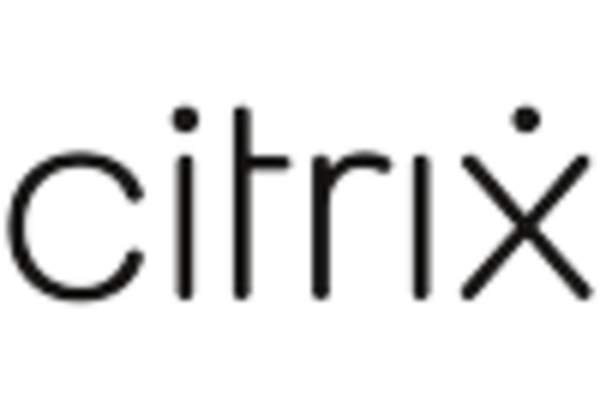Increased Focus on Data Security
Data security is a paramount concern for organizations in Argentina, significantly influencing the virtual desktop-infrastructure market. With the rise in cyber threats and data breaches, businesses are prioritizing secure access to sensitive information. Virtual desktop solutions offer enhanced security features, such as centralized data storage and robust access controls, which are appealing to organizations looking to safeguard their data. The market is witnessing a shift towards solutions that provide advanced security measures, including encryption and multi-factor authentication. This heightened focus on security is reflected in a growing investment trend, with companies allocating approximately 20% of their IT budgets to cybersecurity initiatives. As organizations strive to protect their digital assets, the demand for secure virtual desktop infrastructures is expected to rise, further propelling market growth in Argentina.
Regulatory Compliance Requirements
The virtual desktop-infrastructure market in Argentina is also being shaped by the increasing regulatory compliance requirements imposed on businesses. Organizations are required to adhere to various data protection regulations, which necessitate the implementation of secure and compliant IT solutions. Virtual desktop technologies facilitate compliance by providing centralized control over data access and storage, making it easier for organizations to meet regulatory standards. This compliance-driven approach is particularly relevant in sectors such as finance and healthcare, where data privacy is critical. As companies navigate the complexities of regulatory frameworks, the demand for virtual desktop solutions that support compliance efforts is likely to grow. This trend indicates a robust opportunity for the virtual desktop-infrastructure market to expand as businesses seek to align their IT strategies with regulatory mandates.
Growing Demand for Remote Work Solutions
The virtual desktop-infrastructure market in Argentina is experiencing a notable surge in demand for remote work solutions. As organizations increasingly adopt flexible work arrangements, the need for secure and efficient remote access to desktop environments has become paramount. This shift is reflected in a reported growth rate of approximately 15% in the adoption of virtual desktop solutions among businesses in Argentina. Companies are seeking to enhance productivity while ensuring data security, which is driving investments in virtual desktop technologies. The ability to provide employees with seamless access to applications and data from any location is a key factor contributing to the expansion of the virtual desktop-infrastructure market. Furthermore, this trend is likely to continue as more organizations recognize the benefits of remote work capabilities, thereby solidifying the market's growth trajectory in the coming years.
Cost Efficiency and Resource Optimization
Cost efficiency remains a critical driver for the virtual desktop-infrastructure market in Argentina. Organizations are increasingly recognizing the potential for significant cost savings through the implementation of virtual desktop solutions. By centralizing desktop management and reducing the need for physical hardware, companies can lower their IT expenditures. Reports indicate that businesses can achieve up to a 30% reduction in operational costs by transitioning to virtual desktops. This financial incentive is particularly appealing to small and medium-sized enterprises (SMEs) in Argentina, which often operate with limited budgets. Additionally, resource optimization through virtualization allows for better allocation of IT resources, enabling organizations to focus on strategic initiatives rather than routine maintenance. As cost considerations continue to influence decision-making, the virtual desktop-infrastructure market is likely to see sustained growth driven by this economic rationale.
Technological Advancements and Innovation
Technological advancements are playing a pivotal role in shaping the virtual desktop-infrastructure market in Argentina. Innovations in cloud computing, artificial intelligence, and machine learning are enhancing the capabilities of virtual desktop solutions. These advancements enable organizations to provide more efficient and user-friendly desktop experiences, which is increasingly appealing to end-users. The integration of AI-driven analytics into virtual desktop environments allows for improved performance monitoring and resource allocation. Furthermore, as technology continues to evolve, businesses are likely to seek out cutting-edge solutions that offer enhanced functionality and scalability. This drive for innovation is expected to stimulate growth in the virtual desktop-infrastructure market, as organizations aim to leverage the latest technologies to optimize their IT operations and improve overall productivity.
















